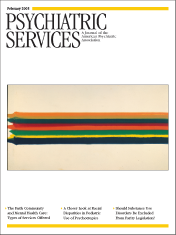February 2005: This Month's Highlights
The Faith Community and Mental Health Care
Initiatives to provide federal funds to faith-based agencies have raised serious concerns about the constitutional separation of church and state. However, many people turn first to clergy or to other resources within their faith community when they experience symptoms of mental illness. In this issue of Psychiatric Services two reports present the results of surveys that examined services available within the faith community. Sixty-two imams of U.S. mosques completed a questionnaire sent to them by Osman M. Ali, M.D., and his colleagues in regard to their role as a counselor and the reasons that their congregants seek help (see page 202). The respondents to the second survey, by Emily Dossett, M.D., M.T.S., and her coauthors, were 42 partner organizations in QueensCare Health and Faith Partnership, a network of congregations, faith-based nonprofit organizations, religious schools, and parish nurses in a low-income area of Los Angeles (see page 206). Both surveys found that many congregants sought personal and family counseling but that most clergy and other individuals who provided the counseling lacked any professional training. In a Taking Issue commentary, Norman A. Clemens, M.D., notes that collaboration and consultation between clergy and mental health professionals can benefit individuals with mental disorders (see page 133).
Parity: Should Substance Use Disorders Be Excluded?
In this month's Alcohol & Drug Abuse column, Shelly F. Greenfield, M.D., M.P.H., the column's editor, examines the question "Is Parity for the Treatment of Substance Use Disorders Really Sensible?" She describes variations between states in legislation that mandates parity of coverage for physical and mental disorders—with some states including treatment for substance use disorders and some specifically excluding it. She also reviews evidence from a number of studies showing that fears of dramatically increased costs are unfounded when states and other entities introduce parity within a managed care framework. Dr. Greenfield notes that mental health parity legislation that includes substance use disorders can counter stigma by sending a strong message to the public that these disorders are real and that effective treatments exist (see page 153).
Taking a Closer Look at Disparities in Care
Ethnic and racial disparities in access to and quality of care are the focus of continuing attention. In 2001 they were the subject of a report from the U.S. Surgeon General, and more recently they were the theme of APA's 2004 Institute on Psychiatric Services. In this issue Julie Magno Zito, Ph.D., and her colleagues report research that took a closer look at the disparities between black and white youths in the prevalence of use of psychotropic medications. To drill down into existing data, the authors disaggregated claims in a mid-Atlantic state Medicaid program into four major categories of Medicaid eligibility for youths—two income-based eligibility categories (Temporary Assistance to Needy Families and the State Children's Health Insurance Program) and two special-needs categories (foster care and disability that entitled recipients to Supplemental Security Income). The authors hope that the distinct differences in psychotropic drug use between these groups will help future researchers more closely pinpoint targets for eliminating disparities (see page 157).
Briefly Noted …
• A five-year follow-up study of more than 600 participants in a chemical dependency program investigated whether receipt of psychiatric services in the intervening years would predict abstinence (see page 164).
• An examination of national data from a survey of homeless persons sought to determine whether those with mental illness would attribute their homelessness to their illness or to other factors, such as insufficient income or lack of suitable housing (see page 172).
• A large proportion of people who become involved in the criminal justice system have previous involvement in the mental health system. Does the mental health system serve a similarly large proportion of clients who have past involvement in the criminal justice system? Researchers checked the records of 673 new clients of outpatient mental health agencies to examine this question (see page 179).
• A three-week intensive version of dialectical behavior therapy was effective in improving symptoms of depression and hopelessness when it was provided in an outpatient setting to 121 individuals with borderline personality disorder who were in crisis and suicidal (see page 193).



